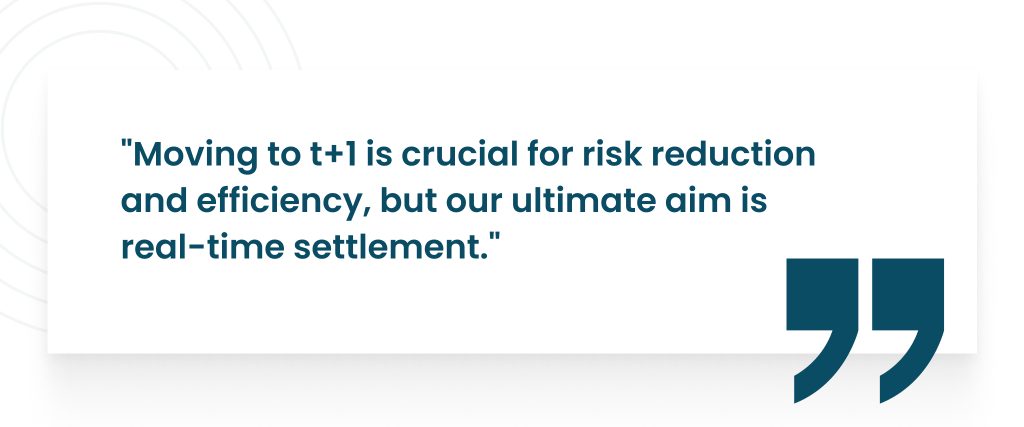The US securities trading industry recently transitioned to a T+1 settlement cycle from T+2, marking a significant change aimed at increasing market efficiency and reducing risk. Canada transitioned to the T+1 settlement cycle for equity and long-term debt market trades on May 27, 2024, ahead of the US market. The Canadian Securities Administrators (CSA) confirmed this move to enhance market efficiency and reduce settlement risks.
SEC Chair Gensler noted that the switch was “smooth, with fail rates remaining stable and not increasing. This has been the overall sentiment across the US, Canada, Mexico, Argentina, and Jamaica, transitioning their settlement cycle for equities, corporate bonds, and municipal securities from T+2 to T+1.
One week into the rollout, we examine how firms have adapted, the successes achieved, and the challenges faced while also exploring the future implications for the capital markets ecosystem.
Prominent Highlights of the First Week: T+1 Settlement
- High Affirmation Rates: A Positive Start
- The first week of T+1 settlement was deemed a success by DTCC officials, reinforcing confidence in the new system. It reported a smooth transition to T+1 settlement, with affirmation rates exceeding 90% on the first day, as opposed 73% in January this year. In Canada, initial responses indicate that the transition has been smooth, with market participants effectively adapting by implementing best practices such as same-day allocations and affirmations.
- This is a promising start, indicating that the majority of trades are being processed efficiently within the shortened timeframe. This high rate indicates a robust adjustment to the new system and has a bearing as a crucial step towards the eventual goal of T+0 settlement.
- Showcasing Operational Readiness: Firms Step Up
- Many firms demonstrated commendable operational readiness by enhancing their pre-trade and post-trade processing workflows. According to a report by Markets Media, firms like Bank of America and Goldman Sachs had detailed readiness plans in place well before the transition date. These plans included comprehensive testing and coordination with the DTCC to ensure a seamless shift to the new settlement cycle.
“Our preparation for T+1 has been extensive, involving multiple rounds of testing and close collaboration with our clearing and settlement partners,”
A senior executive from Goldman Sachs
Not without Hiccups
- Technical Glitches
Despite the overall success, the first week was not without its technical challenges. Minor system issues were reported by the DTCC during the night cycle processing on the first day. Although these issues were quickly resolved, they highlighted the potential for technological hiccups in the early stages of implementation.
- Persistent Trade Failures
Trade failures remained steady during the first week, as reported by Bloomberg. This indicates that some operational inefficiencies still need to be addressed, emphasizing the need for continuous improvement and monitoring to ensure seamless processing.
- Low Self-Affirmation Rates
Self-Affirmation rates fell below expectations, pointing to areas that require further attention. This gap suggests that while the infrastructure is largely in place, firms need to fine-tune their internal processes to fully align with T+1 requirements. Achieving high self-affirmation rates often requires advanced technological solutions, such as automated trade matching and reconciliation systems. Firms with low self-affirmation rates might be lagging in technology adoption, impacting their ability to comply with T+1 settlement.
Industry Insights and Future Outlook: Towards T+0

Many industry experts view the move to T+1 as a crucial step towards the ultimate goal of the T+0 settlement. This perspective underscores the ongoing efforts to further shorten settlement cycles, which will require more advanced technological solutions and, of course, automation.
Automation of post-trade processes is key to successfully navigating the T+1 settlement system because it helps expedite the timely and accurate provision of data between counterparties.
The reliance on advanced automation and technologies like AI and Blockchain will increase, considering that they can provide real-time processing capabilities, further reducing settlement times and enhancing the overall efficiency of the post-trade process.
Additionally, the transition has further highlighted the importance of industry-wide collaboration.
Firms must work closely with clearinghouses, regulators, and technology providers to address any emerging issues promptly and ensure the smooth operation of the new settlement cycle.
For Wall Street brokers, this transition presents a constant call to action, necessitating a proactive mindset to stay competitive.
Implications for Europe and Beyond
The successful implementation of T+1 in North America offers valuable lessons for other regions considering similar transitions. European markets, for example, are closely monitoring this shift as they contemplate their own move to shorter settlement cycles. The ability to manage operational readiness, address technical challenges swiftly, and maintain high levels of trade affirmation are critical factors that can inform global best practices.


